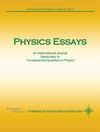四维空间与纠缠原理
IF 0.5
Q4 PHYSICS, MULTIDISCIPLINARY
引用次数: 0
摘要
本文重点探讨了纠缠现象背后的原因,这仍然是一个未知的基本问题。它认为,当两个纠缠粒子在三维空间中分离时,它们之间的信息流是通过四维空间瞬时流动的。四维空间与其他三维空间一样,以长度为测量单位。我们称其为 Q,源自法语中的 quatre(四)。它的大小等于不变的适当时间 τ 乘以光速 c,即 Q = cτ。四维空间中的每个点都对应一个事件。四维空间中事件之间的距离可以用毕达哥拉斯定理计算出来。有人认为,用三维空间中的时钟测量的时间 t 乘以光速,就得到了四维空间中事件的位置矢量长度。在时间 t,当对其中一个纠缠粒子进行观测时,共享相同波函数的两个纠缠粒子在四维空间中的位置矢量长度等于 t 乘以光速,即 ct。对于三维空间中连接两个事件的直线上的所有点来说,时间 t 也是相同的。因此,三维空间中连接两个事件的直线上所有点的位置矢量长度等于四维空间中的 ct。四维空间中的相应点与原点构成等距离弧线。据推测,两个纠缠粒子之间的信息流通过四维空间中的这条弧线时,并不携带能量或质量粒子。因此,它在四维空间中不受时间和光速的限制,是瞬时的。本文章由计算机程序翻译,如有差异,请以英文原文为准。
The fourth dimension of space and the entanglement principle
This paper focuses on the reason behind the entanglement phenomena, which is still an unknown fundamental question. It argues that while two entangled particles are separated in the 3D space the flow of information between them is instantaneous through the 4D space. The fourth dimension
of space has the unit of measurement of length like the other three space dimensions. We shall call it Q, from the word quatre (four) in French. Its magnitude is equal to the invariant proper time τ times the speed of light c. Q = cτ. Each
point in the 4D space corresponds to an event. Distances between events in the four-dimensional space can be computed using the Pythagoras theorem. It is argued that time t as measured by clock in our 3D space times the speed of light gives the length of the position vector of an event
in the 4D space. At time t, when an observation is made at one of the entangled particles, the length of the position vectors of both entangled particles, sharing the same wave function, in 4D space are equal to t times the speed of light, i.e., ct. The time t is also
the same for all the points on the line connecting the two events in the 3D space. Consequently, the length of the position vectors of all the points on the line connecting the two events in the 3D space is equal to ct in the 4D space. The corresponding points in the 4D space make an
arc of equidistance to the origin. It is conjectured that the flow of information between the two entangled particles through this arc in the 4D space is not carried by energy or mass particles. It is, therefore, not bound by the time nor the speed of light constraint in 4D space and is instantaneous.
求助全文
通过发布文献求助,成功后即可免费获取论文全文。
去求助
来源期刊

Physics Essays
PHYSICS, MULTIDISCIPLINARY-
自引率
83.30%
发文量
50
审稿时长
6-12 weeks
期刊介绍:
Physics Essays has been established as an international journal dedicated to theoretical and experimental aspects of fundamental problems in Physics and, generally, to the advancement of basic knowledge of Physics. The Journal’s mandate is to publish rigorous and methodological examinations of past, current, and advanced concepts, methods and results in physics research. Physics Essays dedicates itself to the publication of stimulating exploratory, and original papers in a variety of physics disciplines, such as spectroscopy, quantum mechanics, particle physics, electromagnetic theory, astrophysics, space physics, mathematical methods in physics, plasma physics, philosophical aspects of physics, chemical physics, and relativity.
 求助内容:
求助内容: 应助结果提醒方式:
应助结果提醒方式:


